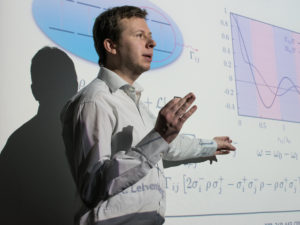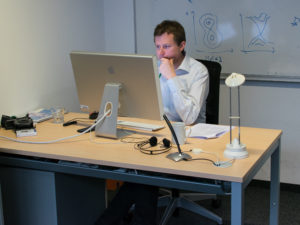Physics
Research Statement
 My research investigates collective effects in ensembles of coupled atomic dipoles. In such systems, the presence of the electromagnetic vacuum and its fluctuations lead to coherent energy exchange amongst the individual constituents and, most importantly, to collectively enhanced or decreased spontaneous emission through constructive and destructive interference, dubbed super- and subradiance, respectively.
My research investigates collective effects in ensembles of coupled atomic dipoles. In such systems, the presence of the electromagnetic vacuum and its fluctuations lead to coherent energy exchange amongst the individual constituents and, most importantly, to collectively enhanced or decreased spontaneous emission through constructive and destructive interference, dubbed super- and subradiance, respectively.
In my doctoral theses, I have studied those effects with a particular focus on improving optical lattice clocks, while my current research deals with superradiance in optical fibers and waveguides as well as collectively modified spontaneous emission and its consequence on quantum information systems.
Protected State Enhanced Quantum Metrology
Collective Radiation of Coupled Atomic Dipoles and the Precise Measurement of Time
 Ultracold optical lattice atomic clocks have made it to the forefront of timekeeping and spectroscopy over the last decade. A prominent example, that features a relative precision of $2\cdot10^{-18}$ in the measurement of one second, is the $^{87}\mathrm{Sr}$ lattice clock at NIST in Boulder, CO. A plethora of fundamental shifts and perturbations has been successfully dealt with in order to arrive at such an admirable measurement accuracy. Yet, there are still phenomena that have not played a limiting role so far, but will become prevalent in the next decade. One of these is dipole-dipole interaction, which constitutes the main subject of this work.
Ultracold optical lattice atomic clocks have made it to the forefront of timekeeping and spectroscopy over the last decade. A prominent example, that features a relative precision of $2\cdot10^{-18}$ in the measurement of one second, is the $^{87}\mathrm{Sr}$ lattice clock at NIST in Boulder, CO. A plethora of fundamental shifts and perturbations has been successfully dealt with in order to arrive at such an admirable measurement accuracy. Yet, there are still phenomena that have not played a limiting role so far, but will become prevalent in the next decade. One of these is dipole-dipole interaction, which constitutes the main subject of this work.
Quantum emitters in close proximity to each other can exchange energy through free space vacuum modes and thus feature shifts and altered spontaneous emission rates in their collective states. Collective spontaneous emission exhibits a drastically different behaviour than emission from a single source: constructive interference can lead to increased spontaneous emission rates, i.e., superradiance, and destructive interference to decreased rates, i.e., subradiance, respectively. As these emission processes are stochastic they constitute a fundamental, inherently uncontrollable perturbation in spectroscopy setups such as atomic clocks.
In this work, we investigate the effect of super- and subradiance on to the Ramsey signal obtained from interacting quantum emitters with a particular focus on $^{87}\mathrm{Sr}$. We show that even small numbers of atoms at high densities can lead to large detrimental effects on precision. Consequently, we suggest an alteration to the Ramsey measurement scheme, where we use phase separation between the individual emitters in order to replace their superradiant behaviour by a subradiant one. This allows for a vast increase in probing time and ultimately a much better sensitivity in the spectroscopic procedure. We investigate our proposed technique for larger systems and find that the increase in probing time scales almost exponentially with the system size, indicating promising results for clock setups.
Furthermore, we develop a procedure that allows subradiant states to be prepared directly as opposed to preparing them by phase alteration. We use phase imprinting in the excitation laser or a large magnetic field gradient to realize almost perfect Rabi oscillations between the collective ground state and the slowest decaying, most subradiant, states in the single- and double-excitation manifold.
And, we employ our findings to study a superradiant laser, whose active medium is given by atoms sitting in a magic wavelength optical lattice. Here, we find that, at magic wavelength distance, the negative effects of dipole-dipole interaction can be largely ignored, while they become prominent at smaller lattice constants.
In additional research conducted during my doctoral studies, we use a mean-field treatment to calculate collective shifts and rates for realistically large systems of emitters in various geometries and find that square or hexagonal lattices seem to suppress collective emission, i.e., feature subradiance, the most.
In a conceptually similar fashion, closely collaborating with the Innsbruck-based experimental photonics group, we investigate emission properties from a quantum dot, where exciton and biexciton emission form a cascade of decay. This setup is aimed at creating time-bin entangled photons, yet other procedures like a Rabi oscillation or a Ramsey scheme have been implemented as well.

